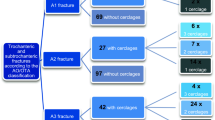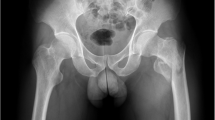Abstract
Objective
This study aims to demonstrate that the use of long cephalomedullary nail and cerclage cables represents a good strategy in order to reduce the high risk of nonunion of the most displaced subtrochanteric fractures.
Methods
This retrospective study examines 44 patients with average follow-up of 23 months, with subtrochanteric fracture type SH IIB, IIC, IIIA, IIIB treated by the same operator and with the same nail and cerclage cables. The clinical results which are derived from THRS have been reported.
Results
Clinical and radiological consolidation occurred in all 44 cases, without re-intervention. The average evaluation derived from the THRS was 48 which corresponds to good, according to the scale.
Conclusions
Considering the anatomic reduction achieved in all patients and the clinical results, we can define the use of long cephalomedullary nail and cerclage cables as the most useful technique in the armamentarium of a trauma surgeon for the treatment of the subtrochanteric fractures.


Similar content being viewed by others
References
Bedi A, Toan Le T (2004) Subtrochanteric femur fractures. Orthop Clin North Am 35:473–483
Tomás J, Teixidor J, Batalla L, Pacha D, Cortina J (2013) Subtrochanteric fractures: treatment with cerclage wire and long intramedullary nail. J Orthop Trauma 27(7):157–160
Shukla S, Johnston P, Ahmad MA, Wynn-Jones H, Patel AD, Walton NP (2007) Outcome of traumatic subtrochanteric femoral fractures fixed using cephalo–medullary nails. Injury 38(11):1286–1293
Mustafa S, Koray U, Nadir S (2012) Comparison of reduction methods in intramedullary nailing of subtrochanteric femoral fractures. Acta Orthop Traumatol Turc 46(2):113–119
Rahme DM, Harris IA (2007) Intramedullary nailing versus fixed angle blade plating for subtrochanteric femoral fractures: a prospective randomised controlled trial. J Orthop Surg 15(3):278–281
Seinsheimer F (1978) Subtrochanteric fracture of the femur. J Bone Joint Surg 60–A:300–306
van Doorn R, Stapert JW (2000) The long gamma nail in the treatment of 329 subtrochanteric fractures with major extension into the femoral shaft. Eur J Surg 166:240–246
Muiris TK, Airuddha M, Timothy GH, James AH, Declan R, Mark D (2011) Subtrochanteric hip fractures treated with cerclage cables and long cephalomedullary nails: a review of 17 consecutive cases over 2 years. Injury 42:1317–1321
Theerachai A, Phornphutkul C (2012) Percutaneus cerclage wiring and minimally invasive plate osteosynthesis (MIPO): a percutaneous reduction technique in the treatment of Vancouver type B1 periprosthetic femoral shaft fractures. Arch Orthop Trauma Surg 132:813–822
Thorben M, Tobias T, Christian AK (2011) The benefit of wire cerclage stabilisation of the medial hinge in intramedullary nailing for the treatment of subtrochanteric femoral fractures: a biomechanical study. Intern Orthop (SICOT) 35:1237–1243
Briant-Evans TW, Veeramootoo D, Tsiridis E, Hubble MJ (2009) Dynamic compression plates for Vancouver type B periprosthetic femoral fractures. A 3-year follow up of 18 cases. Acta Orthop 80(5):452–548
Boopalan PRJVC, Jepegnanam TS, Nithyananth M, Venkatesh K, Cherian MV (2012) Functional outcome of biological condylar blade plate of subtrochanteric fractures. J Orthop Sci 17:567–573
Craig N, Sivaji C, Mafulli N (2001) Subtrochanteric fractures. A review of treatment options. Hosp Joint Dis 60(1):35–46
Ruedi TP, Buckley R, Moran CG (2007) AO principles of fracture management—principles—specific fractures. Ann R Coll Surg Engl 91(5):448–449
Brien WW, Wiss DA, Becker V Jr, Lehman T (1991) Subtrochanteric femur fractures: a comparison of the Zickel nail, 95 degrees blade plate, and interlocking nail. J Orthop Trauma 5(4):458–464
Perren SM (2002) Evolution of the internal fixation of long bone fractures. The scientific basis of biological internal fixation: choosing a balance between stability and biology. J Bone Joint Surg Br 84-B:1093–1110
Robinson CM, Houshian S, Khan LAK (2005) Trochanteric-entry long cephalomedullary nailing of a subtrochanteric fractures caused by low energy trauma. J Bone Joint Surg Am 87:2217–2226
Kraemer WJ, Hearn TC, Powell JN, Mahomed N (1996) Fixation of segmental subtrochanteric fractures. A biomechanical study. Clin Orthop Rel Res 332:71–79
Kummer FJ, Olsson O, Pearlman CA (1998) Intramedullary versus extramedullary fixation of subtrochanteric fractures. A biomechanical study. Acta Orthop Scand 69(6):580–584
Tencer AF, Johnson KD, Johnston DWC, Gill K (1984) A biomechanical comparison of various methods of stabilization of subtrochanteric fractures of the femur. J Orthop Res 2:297–305
Steinberg EL, Shavit R (2011) Braided cerclage wires: a biomechanical study. Injury 42(4):347–351
Finsen V (1995) The effect of cerclage wires on the strength of diaphyseal bone. Injury 26(3):159–161
Mark L, Stephan MP, Boyko G (2012) Underneath the cerclage: an ex vivo study on the cerclage–bone interface mechanics. Arch Orthop Trauma Surg 132(1467–1472):11
Nather A, Ong HJC, Aziz Z (2005) Structure of bone. In: Nather A (ed) Bone grafts and bone substitutes Basic science and clinical applications. World Scientific Publishing Company, Singapore, p 16
Acknowledgments
Thanks to Maria Elena Diamanti, graduate language and linguistics, for writing and translation assistance.
Author information
Authors and Affiliations
Corresponding author
Ethics declarations
Conflict of interest
We certify to have no conflicts of interest, so we haven’t financial and personal relationships with other people or organizations that could influence this work. We haven’t accepted employment, consultancies, stock ownership, honoraria, paid expert testimony, patient applications, and grants or other funding.
Rights and permissions
About this article
Cite this article
Persiani, P., Noia, G., de Cristo, C. et al. A study of 44 patients with subtrochanteric fractures treated using long nail and cerclage cables. Musculoskelet Surg 99, 225–230 (2015). https://doi.org/10.1007/s12306-015-0385-9
Received:
Accepted:
Published:
Issue Date:
DOI: https://doi.org/10.1007/s12306-015-0385-9




